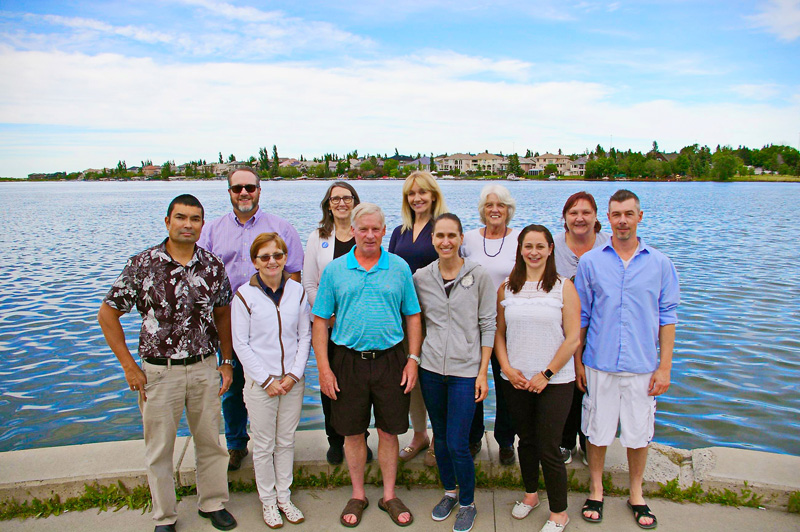The Lake and Watershed Advisory Committee is working to promote long term sustainability of the Chestermere Lake and Watershed.
In 2019, the Lake and Watershed Advisory Committee had four main goals and objectives, including education and communication regarding issues facing Chestermere Lake and Watershed, prevention and control of invasive species in Chestermere Lake, development of a Lake and Watershed Strategy and Management Plan, and shoreline management.
“The Lake and Watershed Advisory Committee is actively engaged in leveraging our member’s expertise and time in working with and supporting City Administration as they move forward with the development of a Lake and Watershed Management Plan,” said a Lake and Watershed Advisory Committee Member Louise Cox.
The Lake and Watershed Management Plan would include a vision and strategy of the lake and watershed, state of the lake and watershed report, and recommendations of stewardship of the lake and watershed.
The Lake and Watershed Advisory Committee focus for 2020 is now creating a Lake and Watershed Management Plan.
“The Lake and Watershed Management Planning is a systematic process,” said a Lake and Watershed Advisory Committee Member Rick Robinson.
“It’s fairly comprehensive, you try to look at a picture of what the risks are to the lake, and what the various users want out of the lake going forward. It’s defensible, it involves a fair amount of science, and typically a scientific advisory committee,” he said.
Adding, “By the end of the process, you can defend any decisions that were made along the way.”
Creating a Lake and Watershed Management Plan is a shared process. It requires input from local and regional stakeholders, council, upstream users, downstream users, users of the lake, and community members.
“The process involves developing a shared vision for the lake and watershed,” Robinson said.
“It’s the typical situation where no one gets everything they want, but everyone gets something they want, and we’re all involved in the process to get there,” he said.
The Lake and Watershed Management Plan will require information, and input from everyone who uses the lake.
“The idea is that no rock is left unturned,” Robinson said.
“Anybody who looks at the lake, we know it’s well used, and it’s well appreciated. There’s a lot of stress on that lake. We want to understand what the vision for the lake and the watershed is going forward,” he said.
Adding, “We want to make sure everyone that’s using the lake and living around the lake shares that vision.”
The process begins with framing, and highlighting the objectives of the process, who is going to be involved, and what the various roles and responsibilities are to guide the process through.
“Following the framing, we get into two pieces of which is science-based, but also socioeconomic based,” Robinson said.
The Lake and Watershed Advisory Committee will look at the existing information on the lake, determine what the existing information states about the current condition of the lake, land use over time, quality of the water, and the natural attributes of the lake.
“We’ve already done some work about recreational use related to the safety, and how is the lake used currently,” Robinson said.
Next, the Lake and Watershed Advisory Committee will develop shared objectives, determine where the lake is now, and where the community wants the lake to be in 10 to 15 years.
To complete the Lake and Watershed Management Plan, specific recommendations, policies, and bylaws based on the found information will be developed.
The Lake and Watershed Advisory Committee will continue to engage with the community to advocate for the lake, the long-term sustainability of the lake, provide education to the community of the established goals, the vision set, and the actions being taken to achieve the goals.
However, the Lake and Watershed Advisory Committee have identified protentional risks to the health and use of the lake, such as over-use, the more people that use the lake for different purposes the more stress on the lake, changes in the water quality, nutrient loading leading to increased plant and algae growth, possible sedimentation, and a change in operating practices.
Changes to the hydrologic regime, such as floods, droughts, and severe weather events caused by climate change, can pose a risk to the health of Chestermere Lake.
Invasive species are also a significant health risk to the lake.
“Flowering rush is one we’re dealing with. Flowering rush can change the lake dramatically, it can change the use, and the quality of the lake,” Robinson said.
“There are some instances of flowering rush almost overtaking some lakes. Once it gets a hold, it really spreads very quickly,” Cox said.
There are cases of flowering rush becoming so dense people are able to stand on the water.
“Once it gets to that point, it’s very, very difficult to remove it,” Cox said.
“These weeds are very resistant, and they can grow to a reasonable depth, they just need a little bit of sunlight to keep them going,” she said.
Adding, “If you don’t have a really deep lake, they can spread across the whole lake and create a swamp area.”
Although there is the possibility that herbicides could help remove the flowering rush, there are only a few that are approved in Canada.
“There is concern around the fact that the water we have in this lake is for agriculture use, you want to be careful what herbicides you put in. It takes a lot of years of applying that to see a reduction. It’s not a magical answer,” Cox said.
“At this point, we are very fortunate that the water lowers, right now the flowering rush that is here is largely around the shoreline and gets exposed,” she said.
Adding, “With the help of the lakefront owners, we are able to continue to remove that by hand, which is proving to be the most effective thing we can do right now, but it is a very big concern.”







